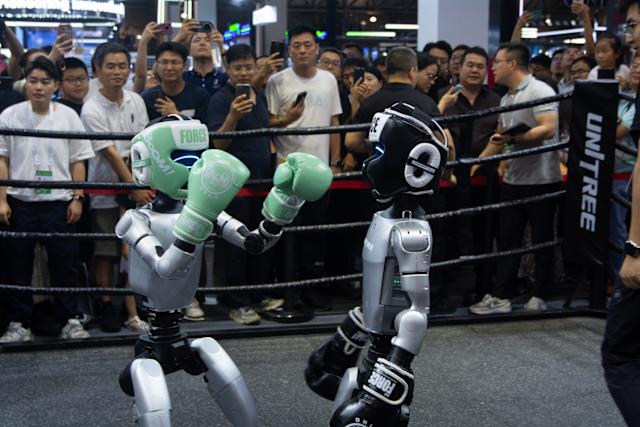China AI innovation is accelerating rapidly. Chinese tech companies unveiled groundbreaking advancements at the World AI Conference in Shanghai. These included new open-source models, powerful computing clusters, and consumer smart glasses. This surge happens despite ongoing US sanctions.
China is intensifying its efforts to lead the global AI landscape. It now dominates the sector alongside the United States. This marks a significant strategic push.
Key Takeaways
- Chinese firms debuted advanced AI technologies in Shanghai. This included open-source models and robust computing clusters.
- New consumer products emerged, such as innovative smart glasses. These showcase practical AI applications.
- These breakthroughs occur despite persistent US sanctions. This highlights China’s strategic resilience.
- China competes intensely with the United United States for AI leadership. Both nations develop most global AI models.
- Innovation moves at “F1 speed.” This signals rapid and sustained progress in China’s AI development.
Table of Contents
China AI Innovation: Unveiling Breakthroughs
The World AI Conference in Shanghai was a key event. Chinese companies showcased their newest AI breakthroughs there. This annual conference is central to China’s national AI strategy.
This year, the focus was on indigenous innovation and self-sufficiency. Chinese firms displayed strong new AI capabilities. This happened despite US sanctions on advanced tech.
New open-source AI models were a major highlight. This strategic move encourages collaborative development. It also allows for wider adoption domestically.
Such models can foster a vibrant AI community. They accelerate innovation across China. They also democratize AI technology for many developers.
This enhances the nation’s overall AI prowess. China builds a strong AI foundation this way. Rapid iteration and deployment become possible.
Sophisticated computing clusters were also featured. These power advanced AI models. They are the backbone of modern AI development.
Clusters train large language models and neural networks. China’s internal infrastructure reduces reliance on foreign suppliers. It ensures strategic autonomy in AI research.
This domestic focus mitigates external tech restrictions. It’s a direct response to geopolitical challenges.
Consumer innovations were also on display. New smart glasses exemplify this trend. They apply AI directly to daily life.
These glasses feature augmented reality and voice assistance. They integrate intelligent features into a wearable format. China’s AI aims for public integration.
It’s not just for enterprise or government use. The goal is to embed AI deeply into society. This fosters public acceptance and use.
Navigating Sanctions and Global Competition
Shanghai’s advancements gain extra meaning. They are seen through ongoing US sanctions. These sanctions target China’s access to cutting-edge tech.
Semiconductors and AI are particularly affected. Yet, Chinese innovation streams continuously. This shows resilience and concerted effort.
They overcome obstacles via domestic R&D. Launching advanced tech, including open-source, under pressure is key. This signals a strategic pivot to self-reliance.
Global AI is defined by high-stakes competition. It’s largely between China and the United States. These two nations dominate the field.
Analysts estimate 85-90% of AI models originate from them. This duopoly highlights AI’s strategic importance. It’s vital for future economic power.
AI impacts national security and tech supremacy. This concentration shows fierce rivalry. It’s a critical domain for global leadership.
This intense competition is a “marathon at F1 speed.” This metaphor captures the relentless pace. High stakes are constantly involved.
It implies sustained effort over time. But also incredibly rapid progress. Every innovation can shift the balance of power.
Both nations commit to long-term AI investment. They push tech boundaries unprecedentedly. There is little room for complacency.
Strategic Implications and Future Outlook
China AI innovation’s implications are far-reaching. Economically, robust AI drives productivity gains. It fosters new industries and services.
This positions China at the digital economy’s forefront. Nationally, AI is critical for defense advancements. It supports intelligence and cybersecurity.
Leadership in AI is a geopolitical imperative. Indigenous AI ecosystems enhance national sovereignty. They reduce reliance on foreign tech.
Chinese firms’ focus on open-source models is noteworthy. Historically, state-backed initiatives favored proprietary development. Now, a shift to open-source occurs.
This fosters a collaborative, dynamic ecosystem. It accelerates innovation by wider developer contributions. Vulnerabilities are identified and frameworks built upon.
It helps establish common standards and practices. Chinese AI may become more interoperable globally. This happens despite geopolitical tensions.
It offers a pathway for companies to advance. Even when facing foreign proprietary restrictions. This ensures continued progress.
The “marathon at F1 speed” will intensify. China and the US heavily invest in AI research. Talent development and infrastructure are key areas.
Showcasing advanced tech at conferences continues. It displays current capabilities. It also signals China’s unwavering commitment.
China aims for global AI leadership. This is regardless of external pressures. AI supremacy shapes global power dynamics.
It influences economics and societal development. This race is more than tech superiority. It’s about defining the future.
Frequently Asked Questions About China AI Innovation
What new AI advancements did China showcase?
China showcased open-source AI models, powerful computing clusters, and consumer smart glasses. These were unveiled at the World AI Conference in Shanghai.
How are US sanctions impacting China’s AI development?
US sanctions aim to restrict China’s access to advanced tech. However, Chinese companies show resilience by focusing on domestic R&D. They also pivot to self-reliance in AI.
Why is China focusing on open-source AI models?
Open-source models promote collaborative development and wider adoption. This accelerates innovation within China’s AI ecosystem. It also helps democratize AI technology.
- 12 Surprising AI Tools That Actually Make You Money (or Save You Time)
- Sam Altman Career Advice 2025
- AI frontrunners bottlenecks: 3 Alarming Challenges Facing Tech Leaders
- Beginner’s guide to automating business processes with AI
- AI Writing Tools Battle: Jasper vs ChatGPT vs Claude – Which Delivers the Best ROI?

